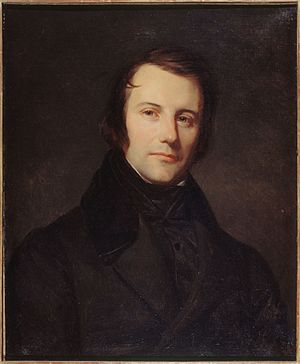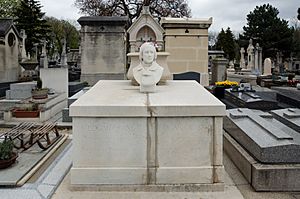Edgar Quinet facts for kids
Edgar Quinet (born February 17, 1803 – died March 27, 1875) was an important French historian and thinker. He was known for his strong beliefs and his writings about history, religion, and politics.
Contents
Biography
Early Life and Education
Edgar Quinet was born in Bourg-en-Bresse, a town in the Ain region of France. His father, Jérôme Quinet, had been an army officer. But he was a strong supporter of the First French Republic and didn't like Napoleon's takeover of the government. So, he left his job and studied science and math instead.
Edgar was an only child and spent a lot of time alone. His mother, Eugénie Rozat Lagis, was a well-educated woman with strong religious ideas. She had a big influence on him.
He went to school first in Bourg and then in Lyon. His father wanted him to join the army and then go into business. But Edgar was determined to become a writer. He eventually convinced his father and moved to Paris in 1820 to follow his dream.
First Writings and Travels
In 1823, Edgar Quinet published his first work, Tablettes du juif errant (which means "Tablets of the Wandering Jew"). This book talked about how humanity makes progress. He became very interested in German writings. To understand them better, he learned German and then translated Johann Gottfried Herder's book, Ideen zur Philosophie der Geschichte der Menschheit ("Outlines of the Philosophy of the History of Man"). This translation, published in 1827, earned him a lot of respect.
Around this time, he met important people like Victor Cousin and Jules Michelet. Before his book came out, he had already traveled to Germany and the United Kingdom. In 1829, Cousin helped him get a job on a government trip to Greece. This was called the "Morea expedition" and happened after the Greek War of Independence against the Ottoman Empire. When he returned, he published a book called La Grèce moderne ("Modern Greece") in 1830.
Later, in 1843, he worked with Michelet on a book. They wrote about their concerns regarding the Jesuits and how they felt this group caused religious, political, and social problems. He also became a big fan of the American writer Ralph Waldo Emerson in 1838. Quinet gave several lectures praising Emerson's work, which were published in 1845 as Le Christianisme et la Revolution Francaise.
After the July Revolution in France, Quinet hoped to get a government job. But his reputation as a strong supporter of republican ideas made it difficult. Still, he started writing for the Revue des deux mondes magazine. For several years, he wrote many essays. One of his most notable essays was about Les Épopées françaises du XIIème siècle. This was one of the first times someone appreciated the old French epic poems called chansons de geste, which had been forgotten for a long time.
His first major original work, Ahasverus, came out in 1833. It was a unique kind of poem written in prose (like a story, not with rhymes).
Soon after, he married Minna More, a German woman he had fallen in love with years before. He started to feel less positive about German ideas because of aggressive actions by Prussia. He then visited Italy. While there, he wrote many essays and two poems: Napoléon (1835) and Prométhée (1838). These poems were written in verse, but many people thought Ahasverus was better. In 1838, he wrote a strong response to David Strauss's book Leben Jesu. That same year, he received the Legion of Honour, a high award in France.
In 1839, he became a professor of foreign literature in Lyon. There, he started giving very important lectures that later became his book Génie des religions. Two years later, he moved to the Collège de France in Paris. His book Génie des religions was published in 1842. In it, he showed understanding for all religions but did not prefer one over others.
Professor in Paris
Quinet's time as a professor in Paris, starting in 1842, was quite famous because of the strong debates he caused. His job was to teach Southern Literature. However, he often focused on other topics. Along with Michelet, he strongly criticized the Jesuits and a movement called Ultramontanism (which supported strong papal authority). Two books with these exact titles came out in 1843 and 1844. As was common for Quinet, these books contained the main ideas from his lectures.
His lectures caused a lot of discussion. Quinet refused to stick strictly to literature. Because of this, in 1846, the government stopped his lectures. Many of his colleagues likely agreed with this decision. He was removed from his position at the Collège de France in 1846. This happened because of his strong criticisms of the Roman Catholic Church, his support for the revolution, his backing of oppressed groups in France, and his belief that religion plays a key role in societies.
The 1848 Revolution
By this time, Quinet was a clear supporter of a republic and somewhat of a revolutionary. He joined the people protesting during the 1848 Revolution. This revolution led to the overthrow of King Louis-Philippe. Quinet was then elected by the Ain region to the Constituent Assembly (which wrote a new constitution) and later to the Legislative Assembly (which made laws). There, he joined the extreme radical political group.
In 1848, he published Les Révolutions d'Italie ("The Revolutions of Italy"), which was one of his most important works. He wrote many short books called pamphlets during the short-lived Second French Republic. He strongly opposed the French military action in Rome. From the very beginning, he was a firm opponent of Prince Louis-Napoléon Bonaparte (who later became Emperor Napoleon III).
Life in Exile
After Louis Napoléon's takeover in 1851, Quinet had to flee France. He lived in Brussels until 1858, and then in Veytaux, Switzerland, until 1870. His first wife had passed away earlier. He then married Hermiona Asachi, the daughter of a Romanian poet named Gheorghe Asachi.
While in Brussels for about seven years, he published Les Esclaves ("The Slaves", 1853), a dramatic poem. He also wrote Marnix de Sainte-Aldégonde (1854), a study about a Reformer, where he highlighted Sainte-Aldégonde's writing skills, and other books.
In Veytaux, he wrote even more. In 1860, he published a unique book called Merlin l'enchanteur (Merlin the Enchanter), which was similar in style to Ahasverus. In 1862, he wrote Histoire de la campagne de 1815 ("History of the Campaign of 1815"). In 1865, he published a detailed book about the French Revolution. In this book, he described terrible acts committed by revolutionary forces, which caused many other supporters of republican ideas to disagree with him. Many pamphlets were written during this time. He also wrote La Création (1870), a third book like Ahasverus and Merlin, but it was more about physical science than history or legends.
Return to France and Final Years
Quinet had refused to return to France to join the liberal group that opposed Napoleon III. But he came back right after the Battle of Sedan during the Franco-Prussian War. He was given his professorship back. During the siege of Paris (1870-1871), he wrote strongly against the Germans.
In 1871, he was elected as a representative for the Seine region to the French National Assembly. He was one of the strongest opponents of the peace terms between France and Germany. He continued to write until his death in Versailles in 1875.
His books Le Siège de Paris et la défense nationale ("The Siege of Paris and the National Defence") came out in 1871, and La République ("The Republic") in 1872. Le Livre de l'exilé ("The Book of Exile") was published in the year he died. After his death, three volumes of his letters and other works were published. In 1858, Quinet had already published a book about his own life and ideas called Histoire de mes idées ("History of My Ideas").
What Was He Like?
Edgar Quinet was a very kind person. His letters to his mother and his stories about his early life show how interesting he was. He also had a strong sense of right and wrong and was very honest in his intentions.
As a writer, his main weakness was that he didn't always focus enough. As a thinker and politician, he could be a bit unclear and sometimes lacked practical plans. His historical and philosophical books, even though they showed he had read a lot, had many ideas, and could express himself well, were often like spoken lectures rather than formal studies. He was better at speaking powerfully than at thinking logically. This meant his work sometimes had contradictions.
These contradictions weren't just because he couldn't or wouldn't argue strictly. They also came from having many different likes and dislikes that he couldn't quite fit into one clear set of beliefs. For example, he loved the beautiful parts of the Middle Ages and Catholicism. But he strongly disliked the limits that medieval and Catholic systems placed on individual freedom. He didn't want to follow any strict set of beliefs. Yet, when someone like David Strauss took different ideas to an extreme, Quinet would disagree.
In politics, he worked with the most radical groups. But he found universal suffrage (everyone voting) to be unreasonable and risky. So, his main characteristic was an eloquent but sometimes vague way of expressing himself. This could be very inspiring and moving at times, but it lacked strong logical arguments and lasting clarity in its form. He made fewer factual mistakes than Michelet, but he wasn't as focused on one idea at a time. Because of this, he rarely achieved the vivid descriptions that Michelet was so good at.
Images for kids
See also
 In Spanish: Edgar Quinet para niños
In Spanish: Edgar Quinet para niños





